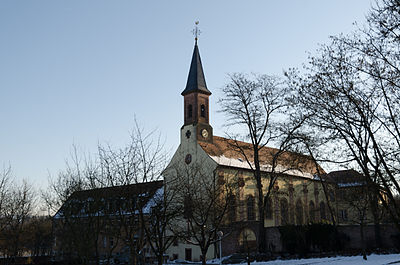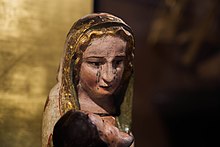Schmerlenbach Monastery
| Schmerlenbach Monastery | |
|---|---|
 Former monastery church and today's parish church and pilgrimage church of St. Agatha |
|
| location | Schmerlenbacher Str. 8, 63768 Hösbach |
| Lies in the diocese | Diocese of Würzburg |
| Coordinates: | 49 ° 59 '10.3 " N , 9 ° 13' 41.9" E |
| Patronage | St. Agatha |
| founding year | 1218 by Benedictine nuns |
| Year of dissolution / annulment |
1982 (since then Pallottine ) |
| Mother monastery | Wechterswinkel Monastery |
The monastery Schmerlenbach is a former Benedictine - Abbey in the district Winzenhohl the municipality Hösbach in Bavaria in the diocese of Wuerzburg .
Surname
etymology
The original name Hagen is based on the Middle High German word hagen ( Latin indago ), which means thorn bush . The later name is derived from the Schmerlenbach flowing through the village .
Earlier spellings
Earlier spellings of the place from various historical maps and documents:
|
|
history
That of the Blessed Virgin Mary, later St. Agatha monastery was founded in 1218 by Gottfried von Kugelberg, provost of Mockstadt and archdeacon of Würzburg. The Kugelbergers were wealthy in the Aschaf Valley and were lords of the Kugelberg Castle 2.5 km to the west , which today is only a castle stable .
The aristocratic women's monastery, which has since been documented as a Cistercian monastery , was finally attached to the Benedictines of the Bursfeld congregation in 1502 under Abbess Elisabeth von Wertheim (1477–1525) . Most recently, the abbess Maria Engelberta von Rothenhausen headed the convent, who in 1758 had the monastery church decorated in the baroque style. In the course of secularization , the monastery was dissolved and handed over to the Kurerzkanzler Karl Theodor von Dalberg . In 1807 he donated the Aschaffenburg clerical seminar from the former property of the monastery. In 1812 Schmerlenbach became its own parish with an attached correctional house for clergy. Georg Scheiblein (1766–1840) became the first director of the correctional house . After the dissolution of the monastery in 1808, the buildings were used by farmers until the 1970s. After that, the Werner and Hedwig Eckert farming family set up an emigrant farm with a farm shop not far from the monastery .
The deceased von Winzenhohl are buried in the former monastery cemetery, next to the church.
In 1982 the complex became the property of the Diocese of Würzburg . The “Maria an der Sonne” training and retreat house was opened in 1985, including numerous new buildings . It has been looked after by Pallottine monks ever since .
After extensive renovation and renovation, from 2017 to 2019, the church was reopened on March 24, 2019, on the solemnity of the Annunciation . Bishop Franz Jung from Würzburg consecrated the new altar designed by the artist Madeleine Dietz from Landau.
Mother of God
The late Gothic figure of Our Lady of Schmerlenbach dates back to around 1380. The saying “make a face like Our Lady of Schmerlenbach” is a saying that is well known in Franconia and refers to the suffering facial expression of the Gothic image of grace in the pilgrimage church in Schmerlenbach.
literature
- P. Franziskus Büll: Sources and research on the history of the medieval women's abbey Schmerlenbach in Spessart , Würzburg 1970.
- Elisabeth Roth: Schmerlenbach, Tradition and New Beginning , Würzburg 1987.
- Günter Fuchs: Schmerlenbach wasn't built in one day either, and the virgins of all six painters. Life and economics in Schmerlenbach Abbey from 1400 until its dissolution , in: Aschaffenburger Jahrbuch Vol. 25/2006 and Vol. 26/2008.
- Remembrance of the Reverend Mr. Georg Scheiblein, royal Bavarian clergyman, jubilee priest, knight of the royal Bavarian Ludwig Order, director of the ecclesiastical correction house and pastor of Schmerlenbach, from one of his friends , publisher of Theodor Perga, Aschaffenburg 1840 ( Google Books ).
- Christl Fuchs, Günter Fuchs, B. Uphoff: Schmerlenbach. Encounters in the mirror of time. Wuerzburg 2011.
Web links
- Schmerlenbach Monastery , basic data and history: Schmerlenbach - Benedictine Sisters in the Spirit of Cîteaux in the database of Monasteries in Bavaria in the House of Bavarian History
- Education house Schmerlenbach
- Parish of St. Agatha Schmerlenbach
- Spessartagen - The abbess in the Schmerlenbacher Walde
Individual evidence
- ↑ a b Wolf-Armin von Reitzenstein : Lexicon of Franconian place names. Origin and meaning . Upper Franconia, Middle Franconia, Lower Franconia. CH Beck, Munich 2009, ISBN 978-3-406-59131-0 , p. 199 ( limited preview in Google Book search).
- ↑ Our Lady of Schmerlenbach at hoesbach.de


